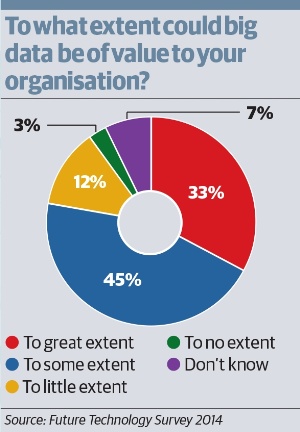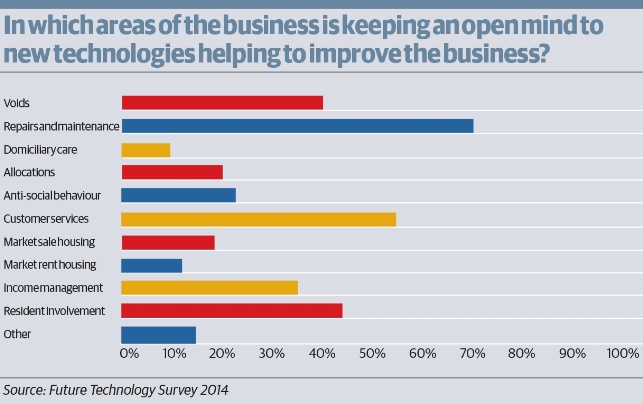You are viewing 1 of your 1 free articles
Tech away menu
Landlords have been awaiting the arrival of a tech-revolution in housing for years. A survey by Inside Housing and asset management and digital software provider, Capita, asks is it any closer, and will organisations put their money where their mouths are and invest? Nick Duxbury reports

Source: Ben Challenor
If the buzz among housing professionals on Twitter is to be believed, after years of empty talk, the social housing sector is finally building an appetitefor new technology.
Over the past year, efforts to dine out on technology in new ways by landlords have included handing out tablets to tenants in order to cut back on call centre use; forays into gathering so-called Big Data for the first time; and the development of apps to engage tenants and to empower people to swap homes (Housing Tinder anyone?).
Scepticism has been the response to some ideas on the menu – think the use of drones to reduce repairs and maintenance bills. And there are certainly plenty who roll their eyes at the mention of ‘innovation’. But the drivers of a tech-revolution in housing are undoubtedly emerging.
“81% of our respondents believe gathering more housing management data is either ‘very valuable’ (47%) or ‘quite valuable’ (34%) in helping make business improvements”
For instance, welfare reform has woken many housing bosses up to need to digitalise their services and protect their income. In response, some organisations are investing more resources behind moving services to mobile and embracing use of social media.
Similarly, the housing regulator’s ever-increasing emphasis on the need to demonstrate value for money is forcing landlords to consider how to improve the efficiency of their asset management, and how they can get better results from their repairs contractors. As a result, software providers are queuing up with ‘exciting opportunities’ that they promise will lead to cost savings.
But are the majority of landlords – not just the vocal early adopters – really willing to put their tenants’ money where their mouths are? Away from the online chatter and chin stroking, what is their real appetite for technology - to what extent is investing in technology a priority or simply a nice-to-have? And just how radical are landlords actually thinking?
Inside Housing decided to find out. In partnership with Capita, we carried out a survey of social housing providers to find out the truth about their attitudes to technology. The findings give plenty of food for thought.
Gauging attitudes
Asked to what extent their organisation has an ‘open mind’ towards the role of new technologies in helping improve their business, it is clear that housing professionals believe their employers have an appetite for tech.
The overwhelming majority - 95% of the 252 respondents – answered either ‘to a great extent’ (52%) or ‘to some extent’ (43%). Of those 95%, there were some clear trends in the areas of business that respondents feel would benefit from investment in new technology. The stand-out area was repairs and maintenance – 70% selected this category.
The other major areas flagged are customer services (55%), resident involvement (41.7%) and voids (40%). Interestingly, income management – the area one might have expected landlords to want to innovate in given the risks posed by welfare reforms – lags behind all of these at 35%.
This doesn’t shock Stewart Davison, business development manager at provider of asset management and digital software, Capita: ‘Voids, repairs and maintenance are at the sharp end of expenditure, so is at the forefront of people’s minds.’
Repair apps
The shift to mobile working among repairs contractors is under way. For instance, Mears is building a mobile app that will enable residents to report repairs on their smart phones, and send photographs of the problem. The reports are sent to the company’s jobs management system and operatives are notified. ‘They take a photo on their phone and book an appointment in real time, as they would when booking a hotel online,’ explains Richard Libby, business solutions manager at Mears. ‘We don’t expect huge uptake at first – but it will get there; look at what has happened with internet banking.’

Similarly, Adam Thompson, managing director at software company Oneserve, maintains that landlords’ appetite for more sophisticated asset management platforms to save money has ramped up. ‘There’s definitely more people approaching us,’ he says. ‘The tech available has become more useable and accessible. On asset management platforms, the focus has moved away from key performance indicators and is now on what a specific engineer is costing.’
This is borne out by the survey which, perhaps unsurprisingly, shows that 81% of our respondents believe gathering more housing management data is either ‘very valuable’ (47%) or ‘quite valuable’ (34%) in helping make business improvements. Once again, the standout area for where data was considered essential was repairs and maintenance. Of those that emphasise the importance of their housing management data, an overwhelming 88% pick out repairs and maintenance as the key focus. Other areas flagged are voids (66%), customer services (63%) and income management (54%).
But this is not the revolutionary ‘internet of things’ technology that many have been predicting will save millions in asset management. The internet of things - effectively smart technology that enables everyday objects (from your kettle to your TV or boiler) to send and receive performance data across an online network – is where all eyes are focused.
‘If you are tracking information over a long period of time, you can start making informed decisions about when to make repairs,’ explains Capita’s Mr Davison, who believes asset management – especially repairs and maintenance – is where this type of technology will be deployed first. Indeed, the survey findings suggest there is an appetite for this among landlords – albeit with a limited sense of where it could be used most effectively.
Respondents, broadly, want everything the internet of things (IoT) has to offer. The proposition of installing sensors on mains electricity wiring to report when there is a fault caught is the most popular application of technology among respondents. A notable 84% say this would be either ‘extremely valuable’ (44%) or ‘quite valuable’ (40%). Similarly, use of sensors on water pipes to report when there is a leak is considered ‘extremely valuable (43%) or ‘quite valuable’ (37%) by 80% of respondents.
In fact, use of sensors to monitor humidity to prevent mould, to monitor use of heating in order to prevent fuel poverty, and to monitor residents’ activity in order people’s homes (to alert landlords to incidents), all proved extremely popular.
‘Big Data goes hand-in-hand with the internet of things. You have to have the skills to mine the data and see what it is telling you. IoT is ideal for asset management. Over years you can use that data to make strategic decisions based on evidence and up to date information,’ adds Mr Davison.
It is odd, then, that landlords appear somewhat unconvinced about the value of Big Data. Only 33% of respondents felt that big data would be valuable ‘to a great extent’ to their businesses, while 45% said it would be to ‘some extent’. Some of the individual responses reveal some of the reasons for this. ‘We need more of our staff to have the skills and the time to analyse existing data before we start on Big Data,’ says one respondent.
Some suggest senior management doesn’t fully understand how technology can aid asset management. One notes that ‘boards and senior management have a long way to go in appreciating the opportunity’ presented by technology.’ Similarly, another warns ‘there needs to be a clearer understanding by procurers of what tech needs to do’, suggesting organisations can take a tick-box approach to requiring contractors to adopting technology.
Prohibitive costs
Unsurprisingly, costs crop up as a barrier. ‘The set up costs are very limiting,’ observes one respondent. ‘As a very small provider, the costs are hugely significant and we are small enough to manage with manual systems.’ But it’s not just the smaller organisations. One employee of a large G15 housing association says that while ‘internet of things’ technology such as sensors is impressive and has the potential to improve lives significantly, ‘money is a big factor’ and warns tenants can’t afford to pay rent increases required to cover the costs.
Behind all of this, though, there is also a sense of suspicion towards embracing new technology and data gathering. Some respondents raise trust-related concerns about data protection and security. ‘There are already ways of getting data without the need for technology gathering it for us,’ says one respondent. ‘There should be no substitute for talking to our tenants face to face.’
‘Technology is fine when it’s working correctly, but there always needs to be some kind of back-up or support in the event of manual or electrical failure,’ adds another.

Asked what might persuade organisations to increase their exposures to and adoption of new technologies, a total of 94% of respondents say that empirical evidence of cost savings would make their employer either ‘extremely likely’ (56%) or ‘quite likely’ (38%) to invest.
A further 87% say the same about a requirement from service commissioners for technology to be used, 77% say tenant pressure would drive them, and 68% say adoption by peers could push them into action.
So, proving cost savings seems to be the key to opening the technological floodgates. The housing sector’s more vocal proponents of the internet of things and Big Data don’t think this will be a big hurdle to overcome.
“The ‘internet of things’ has been notable by its absence in social housing over the past few years”
Matt Leach, chief executive of HACT
‘Landlords are increasingly aware of the value of data, and efforts are being made to improve the quality of the data held,’ insists Matt Leach, chief executive of the housing innovation charity HACT. ‘It hasn’t been invested in as much as it should be – but a lot of landlords are now investing in customer profiling.’
Full potential
Last year, Mr Leach led a group of 20 housing associations into a Big Data experiment. HACT uploaded data from 450,000 homes to a cloud platform which will use an algorithm to predict properties at risk of rent arrears. His hope is that this could also be used to predict when repairs are required and the likelihood of anti-social behaviour.
‘The ‘internet of things’ has been notable by its absence in social housing over the past few years. It is about to explode in a big way in the sector, though. That’s where we will see the next big wave of investment that will have real results that will help customers,’ he argues.
Indeed, so convinced is Mr Leach by the potential of smart technology in social housing he has, in the past two weeks, set up a group of social housing figures to test the use of sensors in homes – the Connected Homes Consortium. He is now in talks with providers in the sensor industry to see how technology could be rolled out in a series of pilots.
‘”Smarthome” solutions are much closer than everyone thinks,’ he concludes, flagging the potential of energy-saving technology to prevent fuel poverty, and wearable technology to monitor residents in the care and support sector.
Capita’s Mr Davison agrees. ‘Landlords need to be factoring this into their asset management plans now. We are not talking years until they need to invest in this stuff – we are talking months.’











